
Euphorbia mellifera, the Canary spurge or honey spurge, is a species of flowering plant in the spurge family Euphorbiaceae, native to Madeira and the Canary Islands. It is an evergreen shrub or tree growing to 2.5 m (8.2 ft) tall and broad, with narrow leaves up to 20 cm (8 in) long. In spring it produces brown, honey-scented flowers.

Sorbus is a genus of over 100 species of trees and shrubs in the rose family, Rosaceae. Species of Sorbus (s.l.) are commonly known as whitebeam, rowan, mountain-ash and service tree. The exact number of species is disputed depending on the circumscription of the genus, and also due to the number of apomictic microspecies, which some treat as distinct species, but others group in a smaller number of variable species. Recent treatments classify Sorbus in a narrower sense to include only the pinnate leaved species of subgenus Sorbus, raising several of the other subgenera to generic rank.

Sempervivum arachnoideum, the cobweb house-leek, is a species of flowering plant in the family Crassulaceae, native to European mountains, in the Alps, Apennines and Carpathians. Growing to 8 cm (3 in) tall by 30 cm (12 in) wide, it is a rosette-forming succulent perennial, valued in cultivation for its ability to colonise hot, dry areas via offsets.
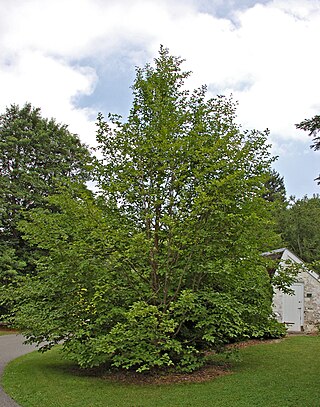
Stewartia pseudocamellia, also known as Korean stewartia, Japanese stewartia, or deciduous camellia, is a species of flowering plant in the family Theaceae, native to Japan and Korea.

Yucca gloriosa is a species of flowering plant in the family Asparagaceae, native to the southeastern United States. Growing to 2.5 m (8 ft), it is an evergreen shrub. It is widely cultivated as an ornamental for its architectural qualities, and has reportedly become established in warmer climates in the wild in various parts of the world.

Phlox subulata the creeping phlox, moss phlox, moss pink or mountain phlox, is a species of flowering plant in the family Polemoniaceae, native to eastern and central USA, and widely cultivated.

Ligustrum ovalifolium, also known as Korean privet, California privet, garden privet, and oval-leaved privet, is a species of flowering plant in the olive family Oleaceae. The species is native to Japan and Korea.

Aria edulis, the whitebeam or common whitebeam, is a species of deciduous tree in the family Rosaceae. It is native to most of Europe as well as North Africa and temperate Asia. Typically compact and domed, with few upswept branches and almost-white underside of the leaves, it generally favours dry limestone and chalk soils. The hermaphrodite cream-white flowers appear in May, are insect pollinated, and go on to produce scarlet berries, which are often eaten by birds.

Genista aetnensis, the Mount Etna broom, is a species of flowering plant in the legume family Fabaceae. It is a large shrub or small tree endemic to Sicily and Sardinia where it is associated with sunny, open landscapes and poor, stony soil. It is a very common constituent of the garigue plant communities, Mediterranean shrubby vegetation, around the lower slopes of Mount Etna, hence its Latin specific epithet aetnensis.
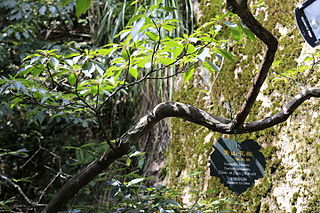
Sorbus commixta, the Japanese rowan, is a species of flowering plant in the family Rosaceae, native to central and eastern China, Korea, Japan, and Sakhalin.

Sorbus sargentiana, commonly known as Sargent's rowan is a species of flowering plant in the family Rosaceae. It is native to southwestern Sichuan and northern Yunnan in China, where it grows at altitudes of 2,000–3,200 m (6,560–10,500 ft).

Gypsophila repens, the alpine gypsophila or creeping baby's breath, is a species of flowering plant in the family Caryophyllaceae, native to the mountains of central and southern Europe, where it grows on dry, chalky slopes. The Latin name literally means "creeping chalk-lover". It is a prostrate, mat-forming herbaceous perennial, growing around 20 cm (8 in) tall by 30–50 cm (12–20 in) wide. For much of the summer it bears masses of star-shaped flowers which may be white, lilac or light purple, in loose panicles.

Sorbaria sorbifolia, the false spiraea, is a species of flowering plant in the family Rosaceae. The common name is also spelled false spirea. Other common names include false goat's beard, sorb-leaved schizonotus, Ural false spirea, and in Chinese: 珍珠梅; pinyin: zhen zhu mei; lit. 'pearl plum'.

Heliopsis helianthoides is a species of flowering plant in the family Asteraceae, known by the common names rough oxeye, smooth oxeye and false sunflower. It is native to eastern and central North America from Saskatchewan east to Newfoundland and south as far as Texas, New Mexico, and Georgia.

Clethra barbinervis, the Japanese clethra, is a species of flowering plant in the family Clethraceae. It is native to eastern Asia, where it is found in southern China, Korea, and Japan. Its natural habitat is in open mountain forests. It is a common species in Japan, and is often found in disturbed secondary forests.
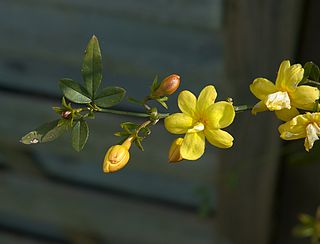
Jasminum mesnyi, the primrose jasmine or Japanese jasmine, is a species of flowering plant in the family Oleaceae, native to Vietnam and southern China. It is also reportedly naturalized in Mexico, Honduras and parts of the southern United States.

Pterostyrax hispidus, the epaulette tree or fragrant epaulette tree, is a species of flowering plant in the family Styracaceae, native to China and Japan. Growing to 15 m (49 ft) tall by 12 m (39 ft) broad, it is a substantial, spreading, deciduous shrub with oval leaves up to 20 cm (8 in) long, and clusters of pure white, fragrant, pendent flowers in summer.
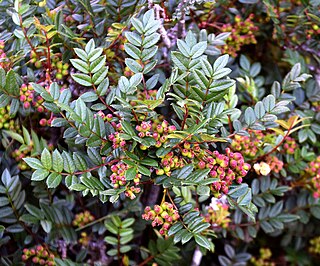
Sorbus reducta, the dwarf Chinese mountain ash, is a species of flowering plant in the family Rosaceae, native to western China (South West Sichuan and North West Yunnan}. Growing to 1.5 m tall by 2 m wide, it is a dense deciduous spreading shrub. Each leaf, 10 cm long, has up to 15 leaflets which turn to brilliant shades of red in the autumn. White flowers in spring are followed by red or pink, and then white berries in autumn.
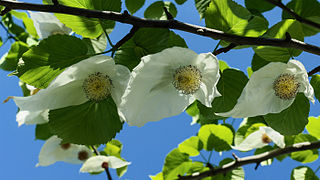
Davidia involucrata, the dove-tree, handkerchief tree, pocket handkerchief tree, or ghost tree, is a medium-sized deciduous tree in the family Nyssaceae. It is the only living species in the genus Davidia. It was previously included with tupelos in the dogwood family, Cornaceae. Fossil species are known extending into the Upper Cretaceous.

Sorbus forrestii, commonly known as Forrest’s rowan, is a species of flowering plant in the family Rosaceae, native to western China. Growing to 8 m (26 ft) tall and broad, it is a spreading deciduous tree with leaves up to 20 cm (7.9 in) long, each divided into up to 19 leaflets (pinnate). White flowers in spring are followed by masses of white berries with pink tips in autumn.




















